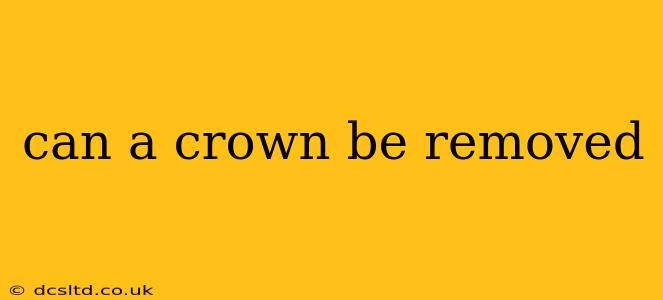Dental crowns are a common and effective restorative treatment, but the question of their removal often arises. The short answer is yes, a dental crown can be removed, but the process and reasons behind it vary. This guide will delve into the specifics, addressing common concerns and providing valuable information.
Why Would a Dentist Need to Remove a Crown?
Several reasons might necessitate the removal of a dental crown. These include:
- Decay or Damage Under the Crown: Even with a crown in place, the underlying tooth can still decay or suffer damage. Removing the crown allows for thorough cleaning, repair of the tooth structure, and potentially a new crown placement. This is a crucial reason for regular dental checkups, even with crowned teeth.
- Crown Fracture or Damage: The crown itself might chip, crack, or become loose. In such cases, removal is necessary to assess the underlying tooth and determine the best course of action – repair, replacement, or alternative treatment.
- Root Canal Treatment: If the tooth under the crown requires a root canal, the crown must be removed to access the pulp chamber. Once the root canal is completed, the crown is usually replaced or a new one is fitted.
- Gum Disease: Advanced gum disease (periodontitis) can impact the stability of a crown, necessitating removal for treatment of the gum disease and potential crown replacement.
- Preparation for other dental procedures: In some instances, a crown might need to be removed temporarily to facilitate other dental procedures, such as implant placement or bridgework.
- Cosmetic Reasons: While less common, a patient might choose to remove a crown for cosmetic reasons, such as replacing an outdated crown with a more aesthetically pleasing one.
How is a Dental Crown Removed?
The removal process itself isn't typically painful, thanks to the use of local anesthesia. The dentist will use specialized instruments to carefully remove the crown, taking care not to damage the underlying tooth. The exact method depends on the type of crown and its adhesion to the tooth. Sometimes, a small amount of pressure or a special dental tool is employed to carefully break the cement seal holding the crown in place.
Is Removing a Crown Painful?
Thanks to modern dental techniques and the use of local anesthesia, crown removal is generally painless. You might experience some slight pressure or discomfort during the procedure, but you shouldn't feel any significant pain. Any post-procedure discomfort is usually mild and easily managed with over-the-counter pain relievers.
What Happens After a Crown is Removed?
After the crown is removed, the dentist will thoroughly examine the underlying tooth for any damage or decay. Depending on the assessment, they will recommend the appropriate treatment, which might include:
- Repairing the tooth structure: Filling cavities or addressing any other damage.
- Root canal treatment: If necessary to address infection or inflammation within the tooth.
- Replacing the crown: Fitting a new crown to restore the tooth's function and aesthetics.
- Alternative treatments: In some cases, depending on the condition of the underlying tooth, the dentist might recommend alternative treatment options such as extraction.
Can I Remove My Crown Myself?
Absolutely not. Attempting to remove a dental crown at home is strongly discouraged. You risk damaging the tooth, causing pain, and potentially leading to further complications requiring more extensive and costly dental work. Only a qualified dentist has the expertise and specialized tools to safely remove a crown.
How Long Does Crown Removal Take?
The time required for crown removal varies depending on several factors, including the type of crown, its adhesion to the tooth, and the condition of the underlying tooth. It usually takes between 15 to 30 minutes, but more complex cases might require a longer procedure.
How Much Does Crown Removal Cost?
The cost of crown removal varies significantly based on your location, the dentist's fees, the complexity of the procedure, and any additional treatment required after removal. It’s best to contact your dentist directly for an accurate estimate of the cost involved in your specific situation.
This comprehensive guide provides a clear understanding of dental crown removal. Remember, always consult a qualified dentist for any dental concerns. They can provide personalized advice and ensure the best possible outcome for your oral health.
